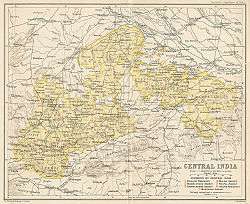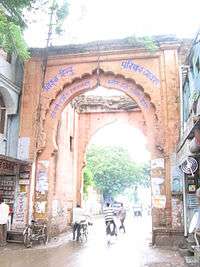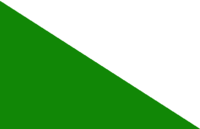Jaora State
Jaora State was a 13 gun-salute princely state of the British Raj. It was part of the Malwa Agency.[1]
| Jaora State जावरा रियासत | |||||||
|---|---|---|---|---|---|---|---|
| Princely State of British India | |||||||
| 1817–1948 | |||||||
 Flag
 Coat of arms
| |||||||
 Jaora located within the Malwa Agency near 4 | |||||||
| Area | |||||||
• 1901 | 1,471 km2 (568 sq mi) | ||||||
| Population | |||||||
• 1901 | 84,202 | ||||||
| Government | |||||||
| • Motto | "Dil o daulat" (Heart and wealth). | ||||||
| History | |||||||
• Established | 1817 | ||||||
• Independence of India | 1948 | ||||||
| |||||||
| Today part of | Madhya Pradesh, India | ||||||


The total area of the princely state, with the dependencies of Piploda and Panth-Piploda, was 1,471 km2 (568 sq mi). Jaora state was divided into four tehsils, Jaora, Barauda, Tal, and Barkhera. The chief crops were millets, cotton, maize and opium. The revenue of the state was Rs.8,50,000 in 1901.
History
Jaora State was founded by Abdul Ghafur Muhammad Khan. 'Abdu'l Ghafur Muhammad Khan was a cavalry officer serving the Pashtun leader Muhammad Amir Khan. He later served the Holkar maharaja of Indore State. The state was confirmed by the British government in 1818 by the Treaty of Mandsaur. The Nawab of Jaora was confirmed the possession of Jaora, Sanjit, Tal, Malhargarh, Bharauda and the right to levy tribute from Piploda. The Nawab was expected to serve the British by providing them with 500 horsemen, 500 footmen and 4 artillery whenever required.[2]
Nawab Muhammad Ismail (ruled 1865-1895) was an honorary major in the British Army. During the reign of Nawab Muhammad Iftekhar Ali Khan (ruled 1895-1947), Piploda became a separate state in 1924, and Panth-Piploda became a province of British India in 1942. Nawab Muhammad Usman 'Ali Khan (ruled 1947-1948) acceded to the Government of India on 15 June 1948.
Jagirdars of Jaora
The chieftains of several petty estates who once paid tribute to Amir Khan Pindari and the other surrounding powers came under the suzerainty of Jaora State after the Treaty of Mandsaur. The Jagirdars were mostly Rajputs apart from Bilaud and Numan Nagdi who were Pathans and Sidri whose thakur was a Mahajan.[3]
- Numan Nagdi
- Amba
- Mandawal
- Bilaud
- Borkhera
- Kherwasa
- Khojankhera
- Sadakheri
- Shujaota
- Sidri
- Sirsi
- Tal
- Uperwara
- Uplai
Nawabs of Jaora
- 6 Jan 1817 - 9 Sep 1825 Abdul Ghafur Mohammad Khan (b. 1775 - d. 1825)
- 9 Sep 1825 – 29 Apr 1865 Ghows Mohammad Khan (b. 1823 - d. 1865)
- 9 Sep 1825 - 1827 Musharraf Begum d/o akhund Muhammad ayaz khan yusufzai of tonk(f) -Regent (d. 1827)
- + Jahangir Khan
- 1827 - 1840 Borthwick -Regent
- 30 Apr 1865 - 6 Mar 1895 Ehtesam al-Dowla Mohammad Ismail Khan aka Nawab Ismail Ali Khan (b. 1854 - d. 1895)
- 30 Apr 1865 - 1872 Regents
- - Hazrat Nur Khan
- - Political Agent Western Malwa
- 6 Mar 1895 – 15 Aug 1947 Fakhr al-Dowla Mohammad Iftekhar (b. 1883 - d. 1947) `Ali Khan (from 12 Dec 1911, Fakhr al-Dowla Sir Iftekhar `Ali Khan)
- 1947 - 1972 Asif ud-Daula, Sahibzada Nawab Usman Ali'Khan Bahadur, Saulat-Jung
- 1972 - 1999 Nawab MOHAMMED MURTAZA ALI KHAN Bahadur Saulat-e-jung (Photo), 6th Nawab of Jaora [9.11.1972] -[19.12.1999], born 4th July 1916 in Jaora; educated at Daly College, Indore and at the Prince of Wales Royal Military College, Dehradun
- 1999 - 2011 Nawab Saulat Mansoor Ali' Khan (b. 1956) [married Meenakshi Mookerjea nee` Begum Meena Mehrnaz (m. 1993)]
See also
References
- Imperial Gazetteer of India, v. 14, p. 63., Digital South Asia Library
- Imperial Gazetteer of India, v. 14, p. 63., Digital South Asia Library
- Leading Famlies And Officials In The States Of Central India pg.136
External links

- Jaora State 2 paisa coin other side, year 1893